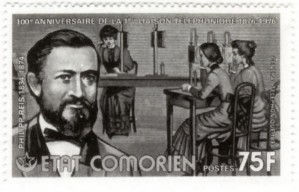LETTERS TO THE EDITOR
Reprinted from "Crown Jewels of the Wire", November 2006, page 4
Hi Howard and Linda,
I got the October issue of CJOW and I thought that the new "In
Design" program seeded to work well. GREAT JOB!!!! It's funny how we learn
all sorts of things while collecting insulator-related stuff. I've got
"Go-Withs" as a side interest. I've collected telephone and insulator
go-with stamps and first day commemoratives from all over the world. When the
October issue showed up with Go-Withs and Telephone Commemoratives, My ears
perked up.
All of the talk and hullabaloo about good ol' Alexander G. is well deserved -
HOWEVER - I picked up a little go-with stuff that everybody either forgot or
didn't know in the first place. It's informative, colorful and short and I
thought you may use it as a filler some time. Whatcha think?
Frank Swies
fswies@wowway.com
|
Phillip Reis (1834 -1874) |
 |
Born in Geinhausen, Germany on Jan. 7, 1834. In 1860, while a 26-year old
science teacher, he began to work on his "Telephon". The motivation
for this project came from a paper delivered in 1854 by a Belgian-born French
inventor named M. Charles Bourseul. Reis successfully demonstrated his original
telephone at a lecture delivered to the Physical Society of Frankfort in 1861.
The society was unimpressed and his "device" never received
recognition or financial support. No patent application ensued. He died, a very
embittered man on Jan. 14 1874, two years before Bell received his patent.
A modest monument to Reis' memory stands in the Friedrichsdorf cemetery. In
1874, a red sandstone monument bearing a medallion portrait was erected by the
members of the Physical Society of Frankfort. His writings, documents and
testimonials of colleagues were published in a book prepared by Sylvanus P.
Thompson in 1883 entitled "Phillipp Reis: Inventor of the Telephone."
This book is available in the New York Public Library.

Dear Howard, I was reading the August issue of Crown Jewels about exhibits at
the National Show in Austin. Reading about the transposition display on page 36
of that issue, I'd like to correct a common misconception.
I worked for 42 yeas on open wire lines. Transpositions were not used to
prevent cross talk between parallel wires. Transpositions were used for open
line induction, which came from power lines. Placing a transposition every third
to fourth pole span would remove the induction power line hum in the telephone
open wire.
Ed Himmelwright
Mr. Banks, I am enclosing a check for my subscription and directory. I look
forward for my magazine each month. The color pictures just add more spice to
it.
I have been a subscriber continuously since 1972. Thank you for the great
magazine, and keep up the good work.
Percy Hill
Thanks, Percy, for your kind words. Your comments spark a question. Has
any reader been subscribing for a period of time longer than Percy's 35
continuous year (through 2007)? Our data base doesn't tell us when people
started with Crown Jewels. So, if you started subscribing before 1972, we'd like
to hear from you.
Howard & Linda.
Crown Jewels has been told of the passing of insulator collector Tom
Moulton last December. Tom was one of the start-up members of the National
Insulator Association, and held member # 169. He was a former member of NIA
board and served as Ethics Chairman.
| 